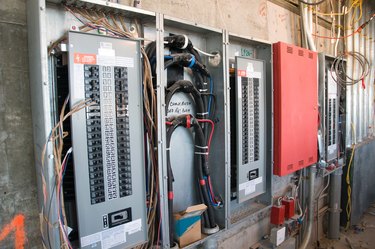Things You'll Need
GFCI circuit breaker
Screwdriver

Ground-fault circuit interrupter (GFCI) devices monitor the hot and neutral lines in circuits to ensure that the current levels are equal. When the processor in the GFCI detects a disparity in the circuit, it trips the circuit, killing power. Where circuit breakers in the service panel protect the wiring in a home, a GFCI protects people from faulty appliances or when they are using appliances in damp conditions. While most GFCI devices are power receptacles linked to a single appliance, it is possible to install GFCI circuit breakers to protect entire circuits.
Replacing an existing breaker
Step 1
Shut off power to the service panel through the main breaker.
Video of the Day
Step 2
Remove the old 220/240-volt breaker by unclipping it from the hot bus bars and disconnect the wires from the old breaker.
Step 3
Connect the hot and neutral wires from the circuit to the setscrews on the GFCI breaker. A third neutral wire, called the pigtail, remains to be connected.
Step 4
Connect the pigtail to the neutral bus bar.
Step 5
Clip the breaker into place on the hot bus bars.
Step 6
Restore power to the service panel and test the new GFCI by pushing the test button. The breaker should trip.
Video of the Day
Adding a new GFCI-protected circuit
Step 1
Make sure your box can accept another 220/240-volt circuit before beginning any work. There must be two adjacent unused spaces in the service panel.
Step 2
Turn off the power to the circuit breaker box.
Step 3
Remove the cover from the empty spaces in the service panel where you will be adding your new breaker by popping them out with your screwdriver.
Step 4
Connect the breaker as described above.